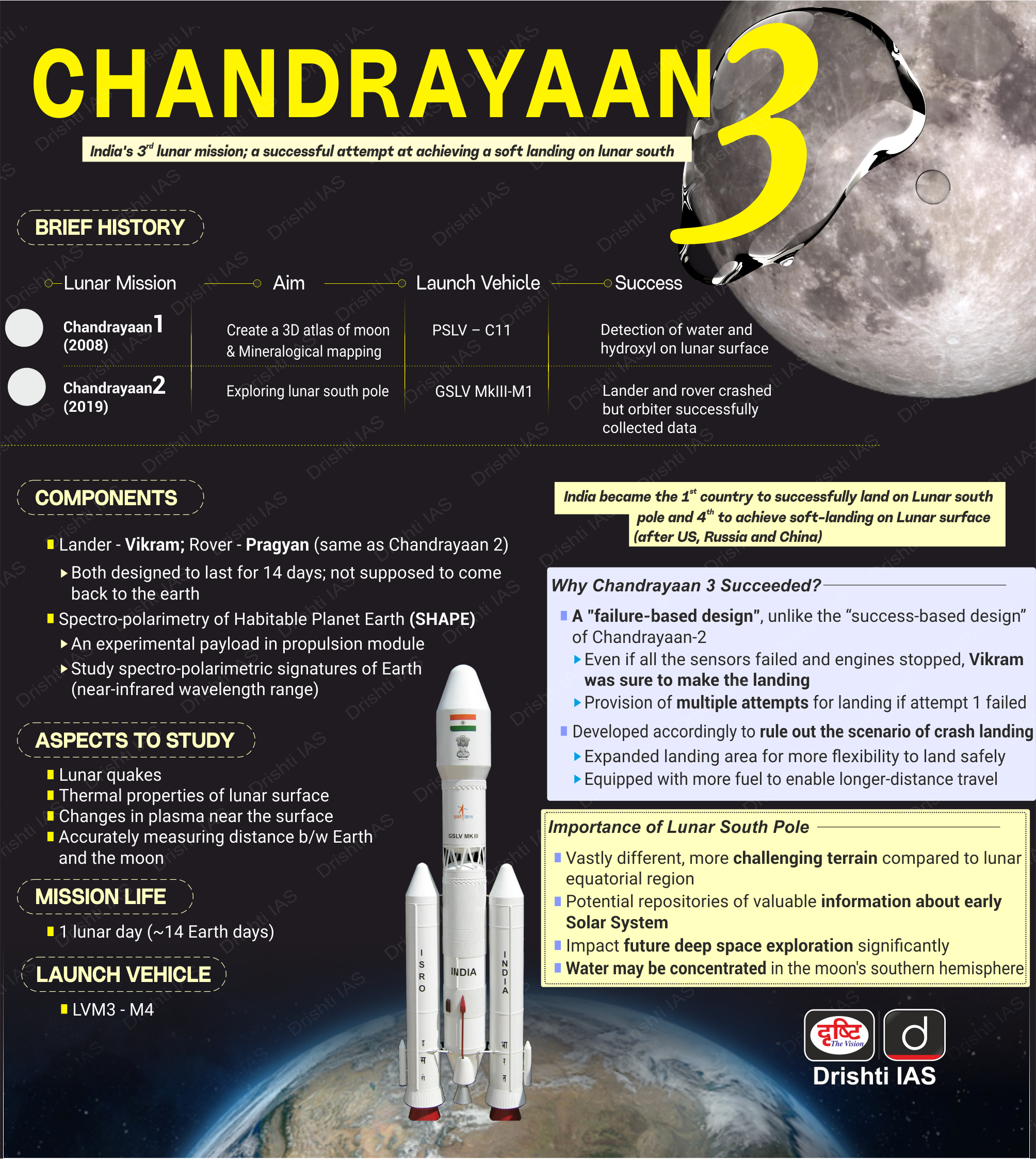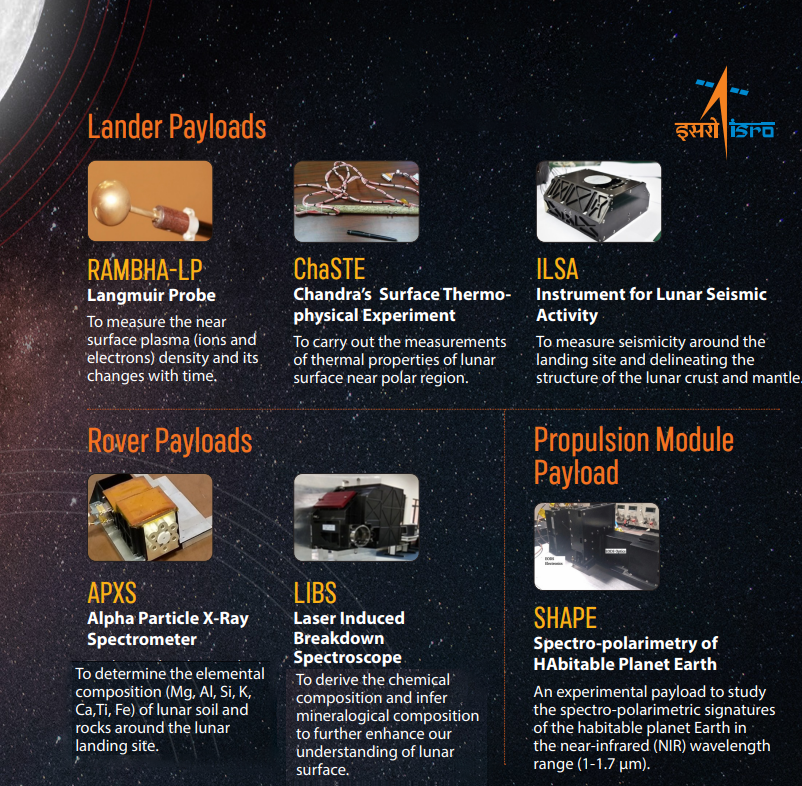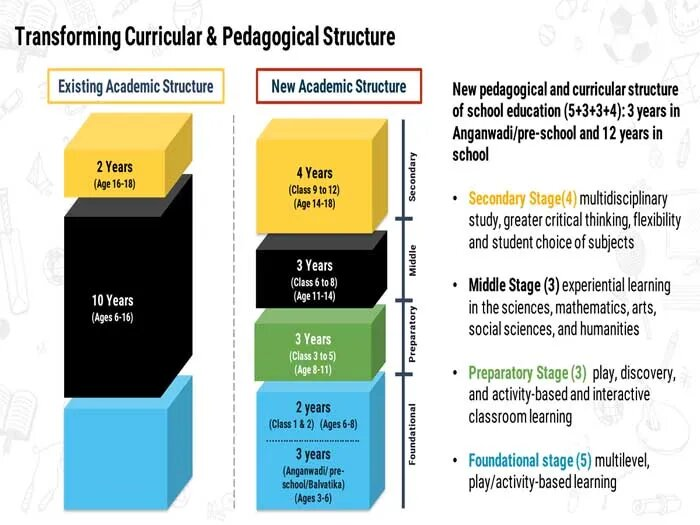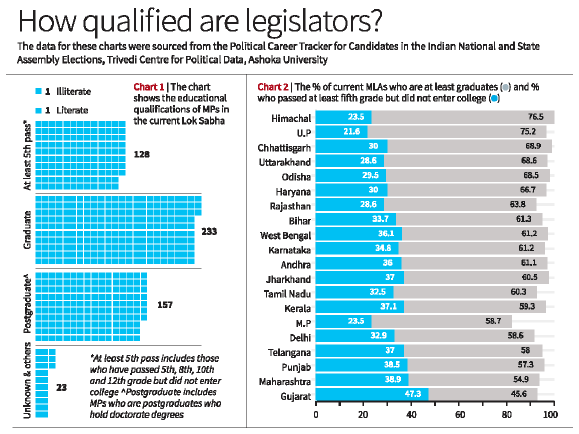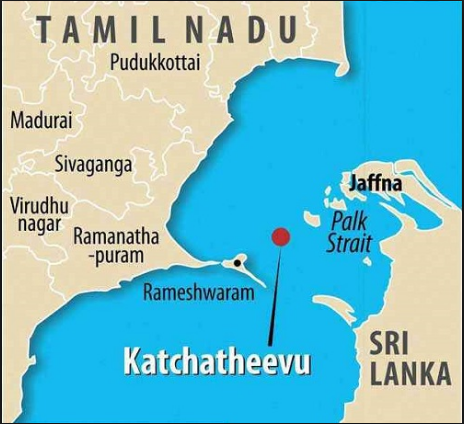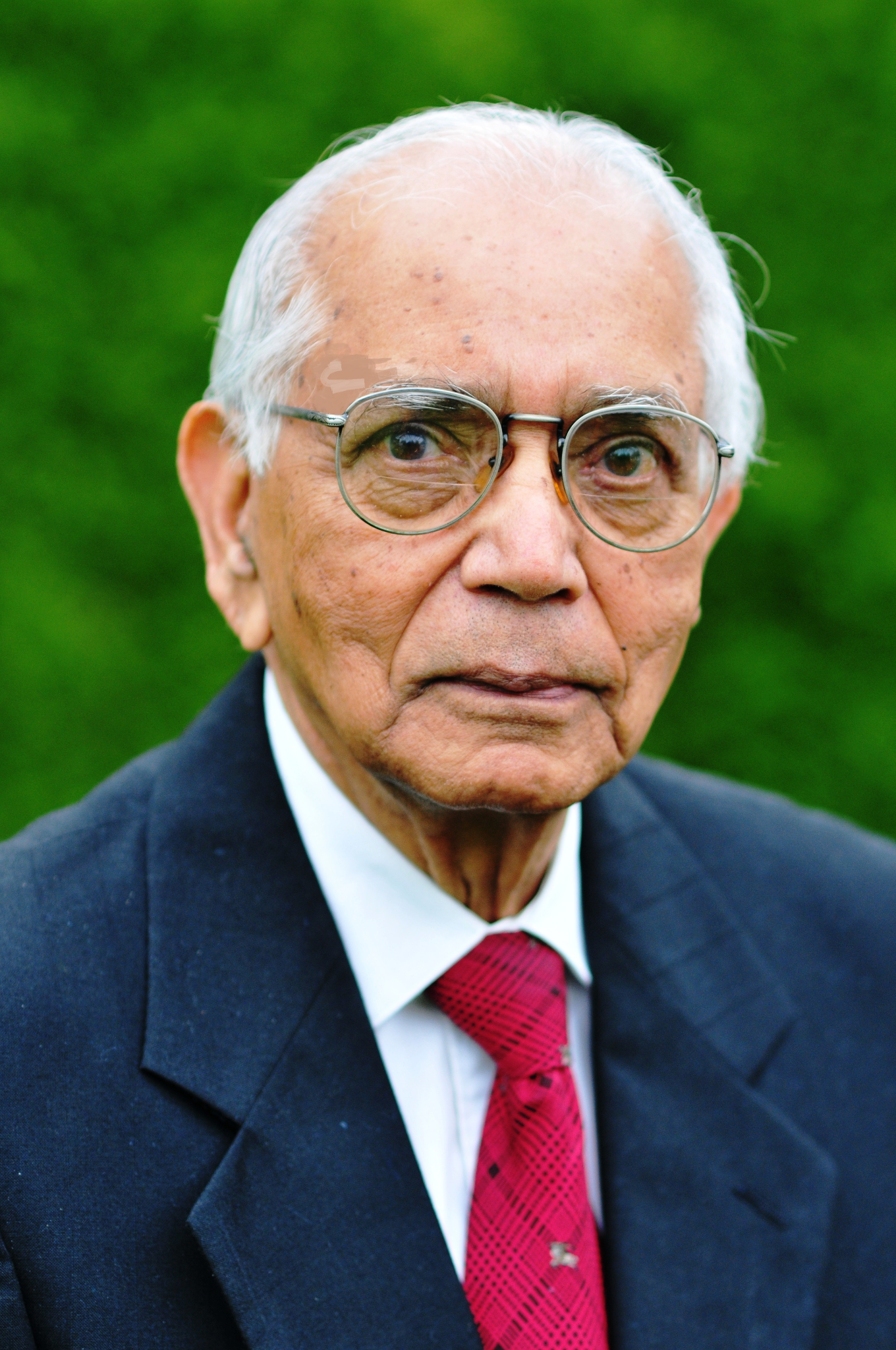Chandrayaan-3 Successfully Lands on Moon's South Pole
For Prelims: Chandrayaan-3, Vikram Lander and Pragyan Rover, Lunar Day, Spectro-polarimetry of Habitable Planet Earth (SHAPE), LUPEX, Aditya L1, NISAR, Gaganyaan, Shukrayaan 1, XPoSat.
For Mains: Objectives of Chandrayaan-3 Mission, Achievements of India in Space Sector.
Why in News?
Chandrayaan-3 has made history by becoming the first mission to soft-land on the lunar south pole, a region that has never been explored before. The mission aimed to demonstrate safe and soft lunar landing, rover mobility, and in-situ scientific experiments.
- India now joins the United States, Russia, and China as one of the few countries to successfully land on the Moon.
How did Chandrayaan-3 Prevail Over Obstacles Encountered in the Previous Mission?
- Chandrayaan-3's successful landing came after the setback of the Chandrayaan-2 mission's landing failure in 2019.
- The Vikram lander of Chandrayaan-2 had lost control and communication during descent, leading to a crash on the lunar surface.
- Lessons from the Chandrayaan-2 mission were applied to Chandrayaan-3, focusing on a "failure-based" design approach to anticipate and mitigate potential issues.
- Critical changes included strengthening the lander's legs, increasing fuel reserves, and enhancing landing site flexibility.
Why did Chandrayaan-3 Choose Moon's Near Side for Landing?
- Chandrayaan-3 aimed to investigate "permanently shadowed regions" near the South Pole for potential water-ice and resources.
- The Vikram lander's controlled descent achieved one of the closest approaches to the Moon's South Pole.
- While a notable achievement, Vikram's landing occurred on the Moon's near side, unlike China's Chang'e 4 on the far side.
- The near side, visible from Earth due to synchronous rotation, covers 60% of the Moon.
- The far side, though not always in darkness, remained hidden until the Soviet spacecraft Luna 3 captured images in 1959.
- Astronauts aboard the Apollo 8 mission in 1968 became the first humans to observe the far side directly.
- The near side boasts smoother surfaces and numerous 'maria' (large volcanic plains), while the far side features massive craters from asteroid impacts.
- The lunar crust on the near side is thinner, causing volcanic lava to flow and fill craters over time, creating flat terrains.
- The decision to land on the near side was driven by the mission's primary goal of a controlled soft landing.
- Landing on the far side would require a relay for communication due to the lack of direct line-of-sight with Earth.
What are the Intended Actions for Chandrayaan-3 after its Landing?
- Chandrayaan-3 is expected to operate for at least one lunar day (14 Earth days) on the lunar surface.
- The Pragyan rover will move around the landing site within a radius of 500 meters, conducting experiments and sending data and images to the lander.
- The Vikram lander will relay the data and images to the orbiter, which will then transmit them to Earth.
- Lander and Rover modules are collectively equipped with advanced scientific payloads.
- These instruments are designed to conduct comprehensive investigations into diverse facets of lunar characteristics, encompassing terrain analysis, mineralogical composition, surface chemistry, atmospheric attributes, and crucially, the exploration for water and potential resource reservoirs.
- The propulsion module that carried the lander and rover configuration till 100 km lunar orbit also has a Spectro-polarimetry of Habitable Planet Earth (SHAPE) payload to study the spectral and Polari metric measurements of Earth from the lunar orbit.
What are ISRO's Future Expeditions?
- Chandrayaan-4: Navigating the Path of Lunar Evolution
- Building upon past missions, Chandrayaan-4 emerges as a potential candidate for a sample return mission.
- If successful, it could mark the next logical step after Chandrayaan-2 and 3, offering the capability to retrieve lunar surface samples.
- The mission holds promise for advancing our understanding of the Moon's composition and history.
- Building upon past missions, Chandrayaan-4 emerges as a potential candidate for a sample return mission.
- LUPEX: Lunar Polar Exploration (LUPEX) mission, a collaborative effort between ISRO and JAXA(Japan), is poised to explore the Moon's polar regions.
- It will be specifically designed to venture into permanently shaded areas.
- Investigating the presence of water and assessing the potential for a sustainable long-term station are among LUPEX's objectives.
- Aditya-L1: Aditya L1 will be the first space based Indian mission to study the Sun.
- The spacecraft shall be placed in a halo orbit around the Lagrange point 1 (L1) of the Sun-Earth system, which is about 1.5 million km from the Earth.
- Observing the sun's corona, emissions, solar winds, flares, and coronal mass ejections are the primary focus areas of Aditya-L1.
- XPoSat (X-ray Polarimeter Satellite): It is India’s first dedicated polarimetry mission to study various dynamics of bright astronomical X-ray sources in extreme conditions.
- The spacecraft will carry two scientific payloads in a low earth orbit.
- NISAR: NASA-ISRO SAR (NISAR) is a Low Earth Orbit (LEO) observatory being jointly developed by NASA and ISRO.
- NISAR will map the entire globe in 12 days and provide spatially and temporally consistent data for understanding changes in Earth’s ecosystems, ice mass, vegetation biomass, sea level rise, ground water and natural hazards including earthquakes, tsunamis, volcanoes and landslides.
- Gaganyaan: Gaganyaan mission aims to send humans to space and return them safely to Earth. The mission will consist of two unmanned flights and one manned flight, using the GSLV Mk III launch vehicle and a human-rated orbital module.
- The manned flight will carry three astronauts, including a woman, for up to seven days in low Earth orbit.
- Shukrayaan 1: It is a planned mission to send an orbiter to Venus, the second planet from the Sun. It is expected to study Venus’s geological and volcanic activity, emissions on the ground, wind speed, cloud cover, and other planetary characteristics.
UPSC Civil Services Examination, Previous Year Question (PYQ)
Q. Discuss India’s achievements in the field of Space Science and Technology. How the application of this technology helped India in its socio-economic development? (2016)
National Curriculum Framework
For Prelims: National Curriculum Framework for School Education, National Education Policy 2020.
For Mains: Features of National Education Policy 2020, Major Issues Related to the Education Sector in India, Government Initiatives Related to Educational Reforms.
Why in News?
Recently, the final National Curriculum Framework (NCF) was released by the National Council of Educational Research and Training (NCERT), leading to significant reforms in the education system, led by the principles of the National Education Policy (NEP) 2020.
- The NCF introduces changes in language learning, subject structure, evaluation strategies, and environmental education, reshaping the educational landscape for Grades 3 to 12 under CBSE.
What are the Key Highlights of the National Curriculum Framework (NCF)?
- Language Learning:
- Students in Classes 9 and 10 learn three languages, with at least two being native Indian languages.
- In Classes 11 and 12, students will study two languages, including one of Indian origin.
- Aim to achieve a "literary level" of linguistic capacity in at least one Indian language.
- Board Exams and Evaluation:
- Students are allowed to take Board exams on at least two occasions in a school year.
- Only the best score among attempts will be retained.
- Students are allowed to take Board exams on at least two occasions in a school year.
- Alignment with NEP 2020:
- The NCF follows the guidelines of NEP 2020. Provides the framework for formulating new textbooks from Grades 3 to 12 under CBSE.
- Textbooks for Classes 3-12 aligned with 21st-century requirements.
- Focus on ensuring rootedness in the current context while being forward-looking.
- The NCF follows the guidelines of NEP 2020. Provides the framework for formulating new textbooks from Grades 3 to 12 under CBSE.
- Changes in Mandatory and Optional Subjects:
- Earlier, students in Classes 9 to 12 studied five mandatory subjects with an option to add one more.
- Now, the number of mandatory subjects for Classes 9 and 10 is seven, and for Classes 11 and 12 is six.
- Earlier, students in Classes 9 to 12 studied five mandatory subjects with an option to add one more.
- Optional Subjects:
- First group includes art education, physical education, and vocational education.
- The second group includes Social Science, Humanities, and interdisciplinary areas.
- The third group includes Science, Mathematics, and computational thinking.
- Flexibility and Choice for Students:
- Redesigned "Secondary Stage" to provide more flexibility and choice.
- No strict separation between academic and vocational subjects, or between Science, Social Science, Art, and Physical Education.
- Students can choose varied subject combinations for their School Leaving Certificates.
- Environmental Education:
- Emphasis on environmental awareness and sustainability.
- Environmental Education integrated across all schooling stages.
- Separate area of study dedicated to environmental education in the Secondary Stage.
- Content Distribution for Social Science Curriculum (Classes 6-8):
- 20% content from local level.
- 30% content from regional level.
- 30% content from national level.
- 20% content from global level.
What is the National Curriculum Framework?
- About:
- NCF is one of the key components of the New Education Policy (NEP) 2020, that enables and energizes this transformation, informed by the aims, principles, and approach of NEP 2020.
- The NCF has undergone four revisions in the past - in 1975, 1988, 2000, and 2005. The proposed revision, if implemented, would be the fifth iteration of the framework.
- Four Sections of NCF:
- NCF for School Education (NCF-SE)
- NCF for Early Childhood Care and Education (Foundational Stage)
- NCF for Teacher Education
- NCF for Adult Education
- Objective:
- It aims to help in positively transforming the school education system of India as envisioned in NEP 2020, through corresponding positive changes in the curriculum including pedagogy.
- It aims to realize the highest quality education for all children, consistent with realizing an equitable, inclusive, and plural society as envisaged by the Constitution of India.
What is the National Education Policy 2020?
- About:
- The NEP 2020 is a comprehensive framework for education reform in India that was approved in 2020, aiming to bring significant changes in the education system of India by providing a holistic and multidisciplinary approach to education.
- Features of the NEP 2020:
- Universalization of education from preschool to secondary level.
- Introduction of a new pedagogical and curricular structure based on the cognitive and socio-emotional development of students.
- Emphasis on the development of foundational literacy and numeracy skills in primary education.
- Increased focus on research and development in education.
What are the Other Government Initiatives Related to Educational Reforms?
- National Programme on Technology Enhanced Learning.
- Sarva Shiksha Abhiyan.
- PRAGYATA.
- Mid-Day Meal Scheme.
- Beti Bachao Beti Padhao.
- PM SHRI Schools.
UPSC Civil Services Examination Previous Year Question (PYQ)
Prelims
Q. Consider the following statements: (2018)
- As per the Right to Education (RTE) Act, to be eligible for appointment as a teacher in a State, a person would be required to possess the minimum qualification laid down by the State Council of Teacher Education concerned.
- As per the RTE Act, for teaching primary classes, a candidate is required to pass a Teacher Eligibility Test conducted in accordance with the National Council of Teacher Education guidelines.
- In India, more than 90% of teacher education institutions are directly under the State Governments.
Which of the statements given above is/are correct?
(a) 1 and 2
(b) 2 only
(c) 1 and 3
(d) 3 only
Ans: (b)
Mains
Q. National Education Policy 2020 is in conformity with the Sustainable Development Goal-4 (2030). It intends to restructure and reorient the education system in India. Critically examine the statement. (2020).
Bacterial Strain to Reduce Methane Emissions
For Prelims: Bacterial Strain to Reduce Methane Emissions, Greenhouse Gas (GHG), Global Warming, Aquaculture.
For Mains: Methane Emissions and Bacterial Strain to Reduce Methane Emissions.
Why in News?
Recently, a study published in the journal Proceedings of the National Academy of Sciences has shown that a strain of bacteria, Methylotuvimicrobium buryatense 5GB1C, can remove methane from major emission sites such as landfills, paddy fields, and oil and gas wells.
- This bacterial strain demonstrates the ability to consume methane, a Greenhouse Gas (GHG) significantly more potent than carbon dioxide, leading to a substantial reduction in Global Warming.
What are the Key Highlights of the Study?
- Bacterial Strain's Role in Methane Reduction:
- The Methylotuvimicrobium buryatense 5GB1C strain of bacteria has been identified as a methane consumer.
- Methane, known for its potency as a greenhouse gas, contributes nearly 30% to total global warming and is over 85 times more potent than carbon dioxide on a 20-year timescale.
- The bacteria's ability to consume methane at low concentrations, as low as 200 ppm, makes it a promising candidate for methane removal technology.
- While other Methane-eating bacteria (methanotrophs) grow best when the methane concentration is around 5,000-10,000 parts per million (ppm).
- The Methylotuvimicrobium buryatense 5GB1C strain of bacteria has been identified as a methane consumer.
- Potential Impact on Global Temperature:
- By employing this bacterial strain, approximately 240 million tonnes of methane emissions can be prevented from entering the atmosphere by 2050.
- This reduction in methane emissions could lead to a global average temperature decrease of 0.21-0.22 degrees Celsius.
- This reduction aligns with global efforts to mitigate climate change and limit temperature rise.
- By employing this bacterial strain, approximately 240 million tonnes of methane emissions can be prevented from entering the atmosphere by 2050.
- Utilization of Bacterial Biomass:
- As the bacteria consume methane, they generate biomass that can be utilized as feed in Aquaculture.
- For every tonne of methane consumed, the bacteria can produce 0.78 tonnes of biomass with a dry weight.
- The economic value of this biomass is estimated to be around USD 1,600 per tonne, providing an additional benefit from the methane reduction process.
What are the Challenges and Considerations?
- Scaling up this technology presents challenges, such as controlling temperature for optimal bacterial growth.
- The bacteria thrive within a temperature range of 25-30 degrees Celsius, necessitating careful temperature management.
- Economic feasibility and energy efficiency are key considerations, particularly in different climates, including temperate, tropical, and arctic regions.
- The researchers emphasize the need for further field studies to assess the feasibility of deploying this technology on a larger scale.
- Analyzing the environmental life cycle and techno-economics of the technology is crucial to ensure both its economic viability and its environmental benefits.
What are the Initiatives to Tackle Methane Emissions?
UPSC Civil Services Examination, Previous Year Questions (PYQs)
Q1. Which of the following statements is/are correct about the deposits of ‘methane hydrate’? (2019)
- Global warming might trigger the release of methane gas from these deposits.
- Large deposits of ‘methane hydrate’ are found in Arctic Tundra and under the sea floor.
- Methane in atmosphere oxidizes to carbon dioxide after a decade or two.
Select the correct answer using the code given below.
(a) 1 and 2 only
(b) 2 and 3 only
(c) 1 and 3 only
(d) 1, 2 and 3
Ans: (d)
Exp:
- Methane hydrate is a crystalline solid that consists of a methane molecule surrounded by a cage of interlocking water molecules. It is an “ice” that only occurs naturally in subsurface deposits where temperature and pressure conditions are favourable for its formation.
- Regions with suitable temperature and pressure conditions for the formation and stability of methane hydrate– sediment and sedimentary rock units below the Arctic permafrost, sedimentary deposits along continental margins, deep-water sediments of inland lakes and seas, and, under Antarctic ice. Hence, statement 2 is correct.
- Methane hydrates, the sensitive sediments, can rapidly dissociate with an increase in temperature or a decrease in pressure. The dissociation produces free methane and water, which can be triggered by global warming. Hence, statement 1 is correct.
- Methane is removed from the atmosphere in about 9 to 12 year period by oxidation reaction where it is converted into Carbon Dioxide. Hence, statement 3 is correct.
- Therefore, option (d) is the correct answer.
World Water Week and Jal Jeevan Mission
For Prelims: World Water Week, Jal Jeevan Mission, Accelerated Rural Water Supply Scheme, Panchayati Raj Institutions, Har Ghar Jal program, Cauvery River dispute, Central Pollution Control Board.
For Mains: Present Status of the Jal Jeevan Mission, Current Challenges Related to Water Resource Management in India
Why in News?
World Water Week, taking place from 20th to 24th August, 2023 is the yearly global water forum organized by Stockholm International Water Institute. This year's theme, "Seeds of Change: Innovative Solutions for a Water-Wise World," spotlights innovation in addressing current water challenges.
- In line, Jal Jeevan Mission, launched in 2019, is envisioned to provide safe and adequate drinking water through individual household tap connections by 2024 to all households in rural India.
- This ambitious initiative aims to learn from the shortcomings of past programs and rectify their failures.
How do Past Rural Water Supply Efforts and Challenges shape the Jal Jeevan Mission?
- Historical Attempts and Shortcomings:
- Initial Efforts (1950s-1960s): The priority of supplying basic water to rural areas was established during India's first five-year plan (1951-56). However, focus was limited to easily accessible villages.
- National Rural Drinking Water Supply Programme (1969): United Nations Children's Fund (UNICEF)'s technical support led to the digging of borewells and piped water connections, but coverage remained uneven.
- Changing Approaches (1970s-1980s): Different initiatives like Accelerated Rural Water Supply Scheme (ARWS) and Minimum Needs Programme were introduced but faced challenges in implementation and coverage.
- Evolution of Mission Approach (1986-1996): ARWS transformed into National Drinking Water Mission and later Rajiv Gandhi National Drinking Water Mission (1991).
- Panchayati Raj Institutions were assigned responsibility for water supply.
- According to a report released by the Comptroller and Auditor General of India (CAG), in most years between 2002 and 2007, stated that the existing schemes could cover only about 50% of the target habitations.
- Initiated in 2017, the Har Ghar Jal program was introduced by the government to provide piped water supply to every household for safe drinking water.
- However, by April 1, 2018, according to the Department of Drinking Water and Sanitation's data, merely 20% of rural households were successfully linked to piped water.
- Principal Shortcomings of Previous Schemes:
- Unsustainable Water Source: Reliance on groundwater led to depletion, making some initially covered villages lose access over time.
- Lack of Community Ownership: Inadequate sense of ownership among communities resulted in poor maintenance and defunct infrastructure.
- Lack of Transparency: Insufficient public awareness and involvement hindered progress and sensitization efforts.
- Mismanagement of Funds: Despite substantial investments, the water supply problem persisted due to inefficiencies in fund allocation and utilization.
- Jal Jeevan Mission: Learnings from the Past:
- Diverse Water Sources: The mission allows for tapping into both surface water and groundwater, focusing on recharge and protection.
- Community Engagement: The mission emphasizes sensitizing communities and implementing officers at all levels, encouraging active participation.
- Information Sharing: A central dashboard publicly shares progress data, fostering healthy competition and encouraging action.
- Holistic Approach: The program encompasses disaster preparedness, bulk water transfers, technological interventions, and greywater management.
What is the Present Status of the Jal Jeevan Mission?
- Objective:
- Jal Jeevan Mission (Rural): The goal of this mission is to provide 55 litres of water per person per day to every rural household through Functional Household Tap Connections (FHTC) by 2024.
- It comes under the Ministry of Jal Shakti.
- Jal Jeevan Mission (Rural): The goal of this mission is to provide 55 litres of water per person per day to every rural household through Functional Household Tap Connections (FHTC) by 2024.
Note: Government of India also launched Jal Jeevan Mission (Urban) that complements JJM(R) and has been designed to provide universal coverage of water supply through functional taps in all 4,378 statutory towns of India
- Current Status:
- As of January 3, 2023, the count of rural households having access to tapped water connections had risen to 108.7 million, equivalent to 56.14%.
- Consequently, the Mission is faced with the task of extending its coverage to an extra 76.3 million rural households (47.3%) within the upcoming two years.
- As reported by the program's dashboard, so far, the Har Ghar Jal status, which involves the provision of tap water supply to all rural households, has been attained by 9 states and Union Territories: Haryana, Goa, Andaman and Nicobar Islands, Puducherry, Daman and Diu and Dadra Nagar Haveli, Telangana, Gujarat, Punjab and Himanchal Pradesh.
- As of January 3, 2023, the count of rural households having access to tapped water connections had risen to 108.7 million, equivalent to 56.14%.
What are the Current Challenges Related to Water Resource Management in India?
- Groundwater Depletion and Urbanization: While the focus is often on surface water sources, groundwater depletion is a significant challenge.
- Rapid urbanization leads to increased demand for water, causing overexploitation of groundwater.
- As cities expand, they cover soil surfaces with impermeable materials, reducing groundwater recharge.
- Interstate Water Disputes and Federalism: Interstate conflicts over water-sharing agreements, such as the Cauvery River dispute between Karnataka and Tamil Nadu, highlight the tensions between state autonomy and national interest.
- Water Quality and Health: Beyond quantity, water quality is a grave issue. Contamination due to industrial discharge, agricultural runoff, and inadequate sanitation leads to the prevalence of waterborne diseases, impacting public health, especially in rural areas.
- Gender Dynamics and Water Collection: In many rural areas, women and girls bear the responsibility of fetching water.
- This not only limits their educational and economic opportunities but also puts them at risk of harassment and violence during long walks to distant water sources.
- Climate Change and Glacial Retreat: The Himalayan glaciers, which serve as a major water source for several Indian rivers, are receding due to climate change.
- This can lead to water shortages in the long term, affecting millions who depend on these rivers for irrigation and drinking water.
- Lack of Efficient Wastewater Management: With water resources in short supply in India, inefficient wastewater management is crippling the country's ability to make the most economic use of it.
- According to a recent report published by the Central Pollution Control Board (March 2021), India’s current water treatment capacity is 27.3% and the sewage treatment capacity is 18.6%.
Way Forward
- Localised Water Resource Management: The Jal Jeevan Mission's role must be viewed from a dual perspective, emphasising both supply management and sustainability of water resources, as Jal Jeevan itself symbolises the life of water. The healthy life of mankind can only be imagined when it is in harmony with the healthy life of water.
- Therefore, there is a need to deploy effective watershed management plans at city level and rain water harvesting should be made mandatory for all the households.
- Water Footprint Labeling: Implement a water footprint labeling system for products, similar to carbon footprint labels, to raise consumer awareness about the water used in producing goods. This can drive demand for water-efficient products.
- Water-Energy Nexus Management: Integrate water and energy management strategies to optimize resource use.
- For example, using treated wastewater for cooling in power plants and using excess heat from industrial processes for water purification.
- Hydro-Responsive Urban Planning: Implement hydro-responsive urban planning by designing cities to adapt to water availability.
- Incorporate flexible infrastructure such as movable flood barriers, adaptable drainage systems, and modular buildings that can be adjusted based on changing water levels.
UPSC Civil Services Examination, Previous Year Question (PYQ)
Prelims
Q. With reference to ‘Water Credit’, consider the following statements: (2021)
- It puts microfinance tools to work in the water and sanitation sector.
- It is a global initiative launched under the aegis of the World Health Organisation and the World Bank.
- It aims to enable the poor people to meet their water needs without depending on subsidies.
Which of the statements given above are correct?
(a) 1 and 2 only
(b) 2 and 3 only
(c) 1 and 3 only
(d) 1, 2 and 3
Ans: (c)
Mains
Q1. What are the salient features of the Jal Shakti Abhiyan launched by the Government of India for water conservation and water security? (2020)
Q2. Suggest measures to improve water storage and irrigation system to make its judicious use under the depleting scenario. (2020)
Educational Qualifications of Political Representatives
For Prelims: Educational Qualifications of Political Representatives, MPs (Member of Parliament), MLAs (Member of Legislative Assembly).
For Mains: Educational Qualifications of Political Representatives.
Why in News?
The recent termination of a Tutor over remarks about voting for educated candidates has sparked a debate on the correlation between political representatives' education and public sentiment.
- The controversy has drawn attention to the educational qualifications of MPs (Member of Parliament) and MLAs (Member of Legislative Assembly) in India's legislative bodies, leading to discussions on the significance of such qualifications in the political landscape.
What is the Scenario of Educational Qualifications of Political Representatives?
- Educational Qualifications of MPs in the Lok Sabha:
- In the current Lok Sabha 72% of MPs have completed their graduation. A small proportion of MPs (less than 0.5%) are classified as illiterate or just literate.
- This data challenges the notion that political representatives are predominantly uneducated.
- In the current Lok Sabha 72% of MPs have completed their graduation. A small proportion of MPs (less than 0.5%) are classified as illiterate or just literate.
- Variations in Educational Qualifications among State MLAs:
- Himachal Pradesh, Uttar Pradesh, and Chhattisgarh have the highest percentages of graduate MLAs, while Gujarat, Maharashtra, and Punjab show lower proportions.
- Trends in Educational Qualifications of MLAs:
- There is a rising trend in the proportion of graduate MLAs in most states.
- However, education data was unavailable for some years in specific states.
Are there any Statutory Provisions Related to Educational Qualifications of MPs and MLAs?
- No Provision for Educational Qualification:
- Indian Constitution does not contain any proper provisions regarding the qualifications that are needed for the Candidates for participating in the elections.
- The RPA (The Representation of the People Act) of 1951 acts outline the qualifications, disqualifications, and other essential aspects of elected representatives.
- Till now there are simple qualifications i.e.
- Resident of the country or a particular area/state from where he wants to stand,
- Not less than 25 years of age and not holding any office of profit.
- Till now there are simple qualifications i.e.
- However, there are no such educational and other moral qualifications mentioned for them.
- Need for a Law:
- Proponents argue that educational qualifications can potentially ensure a certain level of competence, understanding, and analytical skills among elected representatives.
- This, in turn, might enhance the Quality of Governance and Decision-Making.
- As per various data and studies, many foreign countries where educational qualification is necessary, perform well at the country’s growth and economic patterns and also maintain their social backgrounds.
- There are certain subjects which play a key role and we used to study since our childhood i.e. Value Education, Moral Science and Basic Science which also plays a key role over here.
- Opposition of Such Law:
- Opponents of such a law emphasize the importance of Inclusivity and Representation of all sections of society.
- India is marked by its diverse demographics and vast socio-economic disparities.
- Requiring educational qualifications could inadvertently exclude marginalized groups and perpetuate Elitism in politics.
- The essence of Democracy lies in the people's right to choose their representatives.
- While educational qualifications might be a marker of competence, they do not guarantee ethical conduct, dedication to public service, or the ability to understand the needs of various constituencies.
What is the Need for Educated Political Representatives?
- Informed Decision-Making:
- Education equips individuals with critical thinking skills, the ability to analyze complex issues, and a broader understanding of various subjects.
- In politics, informed decision-making is vital for crafting effective policies and making choices that consider long-term consequences.
- Policy Formulation and Analysis:
- Crafting well-informed and effective policies requires a deep understanding of various domains such as economics, law, science, and social issues.
- Educated representatives are better equipped to analyze policy proposals, evaluate their impact, and contribute to discussions with informed insights.
- Addressing Complex Issues:
- Modern societies face multifaceted challenges like technological advancements, climate change, and socio-economic disparities. Educated representatives are better positioned to comprehend the intricacies of these issues and propose comprehensive solutions.
- Communication and Advocacy:
- Educated representatives often possess strong communication skills, enabling them to articulate complex ideas to the public and advocate for policies more effectively. This facilitates transparent governance and encourages citizen engagement.
- Effective Lawmaking:
- Legislators are responsible for drafting and passing laws. An educated representative's legal literacy enables them to craft well-structured, fair, and constitutionally sound legislation.
Katchatheevu Island
Why in News?
Recently, the Tamil Nadu Chief Minister revived the debate over the Katchatheevu, a longstanding point of contention between India and Sri Lanka, particularly with regard to fishing rights and sovereignty over the uninhabited island.
What are the Highlights of the Katchatheevu Issue?
- Historical Background:
- Katchatheevu is a 285-acre uninhabited speck in the Palk Strait, between India and Sri Lanka, an island located about 14 nautical miles off Rameswaram,India.
- In 1974, Prime Ministers Indira Gandhi of India and Sirima R.D. Bandaranaike of Sri Lanka signed an agreement that recognized Katchatheevu as part of Sri Lanka's territory, resulting in a change of ownership.
- The agreement also allowed Indian fishermen to fish around the island, dry their nets on it, and permitted Indian pilgrims to visit the Catholic shrine located on the island.
- Fishing Rights and Livelihood:
- Fisherfolk from both India and Sri Lanka have historically used Katchatheevu for fishing. Though this feature was acknowledged in the 1974 agreement, the supplemental pact was signed in 1976.
- The 1976 agreement was aimed at defining maritime boundaries and exclusive economic zones for both countries, while also imposing restrictions on fishing vessels and fishermen from either nation, prohibiting fishing in each other's waters without explicit permission from either of the two countries.
- Fisherfolk from both India and Sri Lanka have historically used Katchatheevu for fishing. Though this feature was acknowledged in the 1974 agreement, the supplemental pact was signed in 1976.
- Indian Government Stance and Legal Aspects:
- The Indian government, in 2013, stated that the question of retrieval did not arise as no Indian territory was ceded.
- The issue was framed as a dispute between British India and Ceylon (now Sri Lanka), resolved through agreements in 1974 and 1976.
- The Union government asserted that Katchatheevu lies on the Sri Lankan side of the India-Sri Lanka International Maritime Boundary Line.
- Political and Public Sentiment:
- The transfer of Katchatheevu triggered opposition and debates in both Indian Houses of Parliament.
- Leaders of Tamil Nadu have periodically raised the demand for the island's retrieval.
- The demand evolved over the years, with suggestions of a "lease in perpetuity (a lease deed in which no specified time period)" for the island.
UPSC Civil Services Examination, Previous Year Questions (PYQs)
Prelims
Q. Elephant Pass, sometimes seen in the news, is mentioned in the context of the affairs of which one of the following? (2009)
(a) Bangladesh
(b) India
(c) Nepal
(d) Sri Lanka
Ans: (d)
Mains
Q. In respect of India-Sri Lanka relations, discuss how domestic factors influence foreign policy. (2013)
Q. ‘India is an age-old friend of Sri Lanka.’ Discuss India's role in the recent crisis in Sri Lanka in the light of the preceding statement. (2022)
India Post Payments Bank
Why in News?
India Post Payments Bank (IPPB) has marked a significant milestone in the world of banking services with its continued profit streak, demonstrating its commitment to sustainable financial inclusion and citizen empowerment.
- IPPB on August 22,2023 reported its first-ever operational profit of Rs 20.16 crore for 2022-23. The bank saw a 66.12% growth in overall revenue.
What is India Post Payments Bank (IPPB)?
- About:
- Launched on September 1, 2018, with 100% equity owned by the Government of India.
- IPPB embarks on its transformative journey with the launch of pilot branches.
- Pilot branches opened in Ranchi, Jharkhand, and Raipur, Chhattisgarh.
- Leveraging India's vast postal infrastructure with 1,55,000 Post Offices and 3,00,000 postal employees.
- Vision: To create an accessible, affordable, and trusted bank for all citizens.
- Principles and Approach:
- IPPB adopts the principles of India Stack to drive its operations.
- Paperless, Cashless, and Presence-less Banking: Aims to facilitate banking through innovative technology and secure transactions.
- Implements Biometrics integrated smartphones and biometric devices for seamless transactions.
- IPPB delivers simple and affordable banking solutions through intuitive interfaces available in 13 languages.
- IPPB adopts the principles of India Stack to drive its operations.
- Empowering Financial Inclusion:
- IPPB is committed to serving the unbanked and underbanked.
- Contributed to the vision of a less cash economy and Digital India.
- Ensured equal opportunities for financial security and empowerment.
- Empowerment Initiatives:
- Recognized the tireless contributions of Postmen/Gramin Dak Sevaks.
- Introduced 'Niveshak Didi' initiative, for empowering women beneficiaries.
- IPPB introduced services including loan referral services, low-cost health & accidental products like Antyodaya Shramik Suraksha Yojana for Shramyogis registered on the e-Shram portal, Digital Life Certificate to pensioners, citizen services initiatives like Aadhaar-mobile update, child Aadhaar enrolment, Aadhaar based banking transactions (AePS), enabling citizen access to govt. Direct Benefit Transfer programmes like PM KISAN etc.
- Future Goals:
- Aims to transform into a Universal Service platform.
- Leverages technology for expanded accessibility and reach.
- Focuses on innovation to empower citizens and contribute to a digitally inclusive society.
Payment Bank:
- Payments banks were part of the Reserve Bank of India’s strategy of offering differentiated banking licenses.
- A committee headed by Dr. Nachiket Mor recommended setting up of 'Payments Bank' to cater to the lower income groups and small businesses.
- A payments bank is a differentiated bank, offering a limited range of products.
- It can accept demand deposits only that is savings and current accounts, not time deposits.
- Payment banks are restricted to holding a maximum balance of Rs. 2,00,000 (Rupees Two lakh only) per individual customer.
- Payment Banks cannot accept Non-Resident Indian (NRI) deposits.
- The Payment Banks cannot set up subsidiaries to undertake non-banking financial services activities.
Project Worldcoin
Why in News?
Recently, a project called Worldcoin has been launched by OpenAI, an Artificial intelligence company. The project claims to be building the world’s largest identity and financial public network.
What is Project Worldcoin?
- About:
- Worldcoin is an initiative to create a digital network in which everyone can claim some kind of stake, and join the digital economy.
- Worldcoin Working Process:
- The initiative uses a device called “Orb” to collect biometric (iris) data and help participants get a World ID through the World app.
- With the app, participants can collect a cryptocurrency called Worldcoin [WLD].
- Users need to be willing to scan irises and/or get their own irises scanned to make the Worldcoin network possible.
- Those who have their irises scanned and collect a World ID can use this to claim the WLD crypto, which they may use for transactions (if possible and legal) or hold on to the asset in the hope that its price might rise.
- Worldcoin claims that using biometric information to avoid duplication is a valid method for including everyone in its network.
- This process is called “proof of personhood” and makes sure that people do not sign themselves up multiple times in exchange for crypto.
- The initiative uses a device called “Orb” to collect biometric (iris) data and help participants get a World ID through the World app.
- Worldcoin in India:
- The company claimed that India had “proven the effectiveness of biometrics” through its Aadhaar system.
- Worldcoin lists 18 locations in India — largely in Delhi, Noida, and Bangalore — where Orb operators are scanning people’s eyes.
- Criticism of Worldcoin:
- Worldcoin faced early criticisms, with concerns raised about privacy, data security, and the validity of biometric scans.
Cryptocurrency:
- A cryptocurrency is a digital or virtual currency that uses cryptography for security.
- It is a decentralized currency, meaning it is not controlled by any government or institution.
- Some examples of cryptocurrencies include Bitcoin, Ethereum, and Litecoin.
- Transactions with cryptocurrency are recorded on a public digital ledger called blockchain.
- This ledger is maintained by a network of computers around the world, and each new transaction is verified and added to the blockchain by these computers.
UPSC Civil Services Examination, Previous Year’s Questions (PYQs)
Q. With reference to ‘Bitcoins’, sometimes seen in the news, which of the following statements is/are correct? (2016)
- Bitcoins are tracked by the Central Banks of the countries.
- Anyone with a Bitcoin address can send and receive Bitcoins from anyone else with a Bitcoin address.
- Online payments can be sent without either side knowing the identity of the other.
Select the correct answer using the code given below:
A. 1 and 2 only
B. 2 and 3 only
C. 3 only
D. 1, 2 and 3
Ans: B
Rapid Fire Current Affairs
GeM Achieves INR 1 Lakh Crore GMV in Record 145 Days
Government e-Marketplace (GeM) has reached a significant milestone, crossing Rs. 1 lakh crore in Gross Merchandise Value (GMV) within just 145 days in FY 2023-24. GeM is also integrated with e-Gram Swaraj for Panchayat-level procurement.
- Government e-Marketplace (GeM) is an online public procurement portal developed to streamline the acquisition of goods and services by government departments, agencies, and public sector undertakings.
- Launched in August 2016 as part of the "Digital India" initiative, GeM aims to enhance transparency, efficiency, and cost-effectiveness in public procurement while promoting the use of digital technology.
Read more: Government e-Marketplace
Tejas LCA Successfully Fires Indigenous ASTRA Missile
Recently, Tejas, the Light Combat Aircraft (LCA) launched the ASTRA indigenous Beyond Visual Range (BVR) air-to-air missile off Goa's coast.
- The ASTRA missile, a state-of-the-art creation aimed at engaging and neutralizing highly agile supersonic aerial targets.
- It is designed and developed by Defence Research and Development Laboratory (DRDL), Research Centre Imarat (RCI) and other laboratories of DRDO.
- The LCA programme is a project initiated by the Government of India in 1984 to develop and produce a light combat aircraft for the Indian Air Force and Navy.
- It is managed by the Aeronautical Development Agency (ADA)
Dr. Calyampudi Radhakrishna Rao
Dr. Calyampudi Radhakrishna Rao, the world-renowned statistician who pioneered several fundamental statistical concepts, passed away at the age of 102 (22th August 2023).
- C.R. Rao was born on September 10, 1920, in Bellary district, Karnataka in a Telugu family.
- He pioneered several fundamental statistical concepts such as the Cramer–Rao inequality and Rao–Blackwellization.
- Cramer-Rao lower bound, provides a means for knowing when a method for estimating a quantity is as good as any method.
- Rao–Blackwellization provides a means for transforming an estimate into a better—in fact, an optimal—estimate. Together, these results form a foundation on which much of statistics is built.
- The Rao-Blackwell process has been applied to stereology, particle filtering, and computational econometrics, among others, while the Cramer-Rao lower bound is of great importance in such diverse fields as signal processing, spectroscopy, radar systems, multiple image radiography, risk analysis, and quantum physics.
- Dr. Rao was awarded India’s highest honours the Padma Bhushan and Padma Vibhushan in 1969 and 2001, respectively.
KVIC Launched Khadi Rakshasoot for Raksha Bandhan
- Khadi and Village Industries Commission (KVIC) launched 'Khadi Rakshasoot'(Khadi-Rakhi) to commemorate Raksha Bandhan.
- KVIC is a statutory body established under the Khadi and Village Industries Commission Act, 1956.It functions under the Ministry of MSMEs.
- The Rakshasoot was created by dedicated spinner sisters from across rural India who spin multiple threads on the charkha.
- The Rakhi is entirely natural and free of any chemical additives, with some being made from sacred cow dung and seeds of basil, tomato and brinjal.
- The conception behind its making is rooted in the notion that, when disposed of into the earth, it will sprout up into basil, tomato, and brinjal plants.
- The 'Khadi Rakshasoot' is being introduced as a ‘Pilot Project’ initiative available exclusively at Khadi Bhavan in New Delhi.

